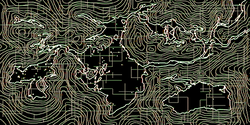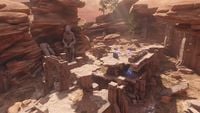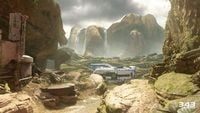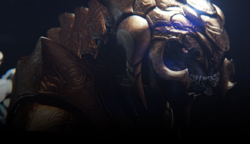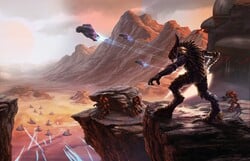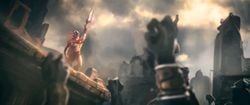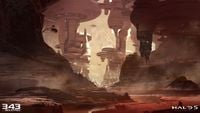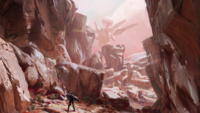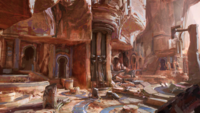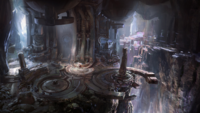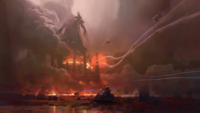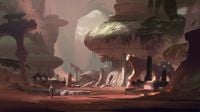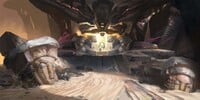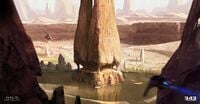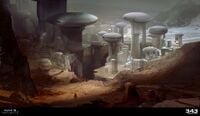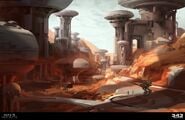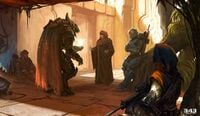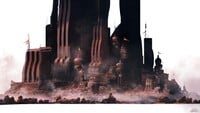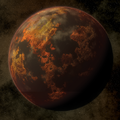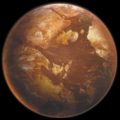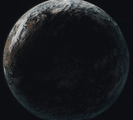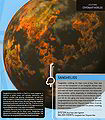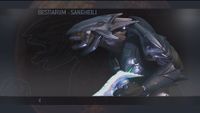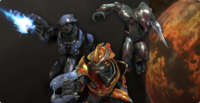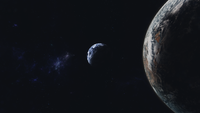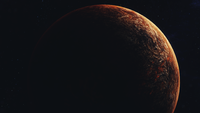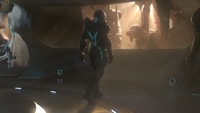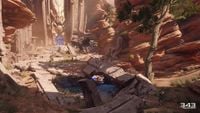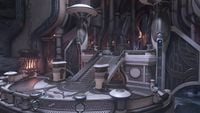Sanghelios
From Halopedia, the Halo wiki
| Sanghelios | |
|---|---|
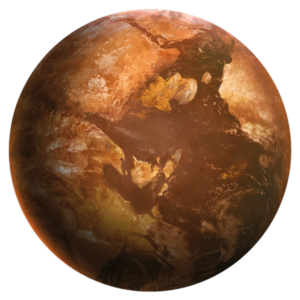
| |
| Astrographical | |
|
System: |
|
|
Orbiting: |
|
|
Orbital position: |
Fourth planet[1] |
|
Moon(s): |
|
| Physical | |
|
Diameter: |
15,038 kilometres (9,344 mi)[1] |
|
Gravity: |
1.375 G[1] |
|
Length of day: |
|
|
Length of year: |
|
|
Atmosphere: |
|
|
Surface temperature: |
-5°C to 96°C (23°F to 204.8°F)[1] |
| Societal | |
|
Demonym: |
Sangheili, Sangheilian (rare)[Note 1] |
|
Species: |
|
|
Population: |
|
|
Government: |
|
- "Sanghelios… she is a beauty of a world."
- — Shipmaster Thon 'Talamee[9]
Sanghelios, also known as Urs IV[10] and designated CE-80-9012 d by the Forerunners,[11] is the homeworld of the Sangheili species. Sanghelios is the fourth planet in the Urs system, a triple star system containing Urs, Fied, and Joori. The planet is orbited by two natural satellites, Qikost and Suban.[3] Sanghelios is a world with a very militaristic and feudal society, a result of the planet's harsh environment.[12]
As a space-faring species, the Sangheili have colonized multiple worlds in addition to Sanghelios as they expanded the reach of their own civilization and later the empire of the Covenant.[13] Though the Sangheili have colonized dozens of independent worlds, Sanghelios still remains central to the government and culture of the species.[14] Following the Human-Covenant War and the dissolution of the Covenant, Sanghelios had become embroiled in a civil war known as the Blooding Years that encompasses most of the planet and many Sangheili colonies.[1] Though the Swords of Sanghelios have effectively taken control of the planet, many other factions seek to overthrow the government.[7]
Overview[edit]
Topography[edit]
A harsh planet, Sanghelios is located on the innermost edge of the Urs system's habitable zone,[15] allowing for a wide variation in vegetation and temperature on the planet.[12] With a diameter of 15,038 kilometres (9,344 mi),[1] Sanghelios has a gravity of 1.375 Gs and an average surface temperature of -5 °C to 96 °C (23 °F to 204.8 °F). The planet has a diameter of 15,038 kilometers, making it larger than Earth. The land masses and continents are more scattered in relation to bodies of water.[3] Sanghelios' sky varies in hue from a bright yellow to a blood red, due to large amounts of suspended particles in the upper atmosphere, but can also be blue. The planet's harsh and capricious environment is caused by Sanghelios' three suns, Urs, Fied, and Joori.[12] Like Earth, its atmosphere consists of oxygen, argon, and nitrogen, but also has a reddish hue to it. Water on the planet can have various hues which include blood red, orange, yellow, cyan, blue and even purple or magenta.[16] The surface of the planet is mostly composed of water, though Sanghelios has five individual continents: Kaepra, Qivro, Tolvuus, Vaardma, and Yermo.[1]
Large desert regions stretch across the interior portions of the planet's continents, forcing the significant portion of Sanghelios' population to live on the coasts and islands. These locations are usually encircled by steep mountain ranges or rocky tombolo drifts, which provide much needed protection during the planet's harrowing rain season.[1] Many Forerunner artifacts and structures exist on the planet, which are the topic of worship, as well as the cause of historical wars between the Sangheili and the San'Shyuum before the formation of the Covenant.[3] The large size of Sanghelios' two natural satellites—Qikost and Suban—has great effects on the planet's tides.[17] Much like Earth's Satellite Luna, Frigid winds from the south pole of Sanghelios were spread across the southern regions of the planet.[18]
Ecology[edit]
Sanghelios is home to numerous animal and plant species, widely different from those on Earth. Some of these animals are domesticated, like the colo which is farmed across Sanghelios for its meat.[19] Doarmir are furry animals that are hunted for their fur, which is used for clothing.[20] Helioskrills are large, predatory creatures that live in the mountains of Sanghelios, respected by the Sangheili for their hunting positions.[21] Intestinal parasites—nishum—are common pests on the planet.[22] The waters on Sanghelios are home to large, predatory aquatic cephalopods that prey on unsuspecting creatures that wander into their territory,[23] alongside Electric kesh, Snap-tails.[24] The skies of Sanghelios are often filled with a variety of avian-like animals.[25] Sangheili farmers would train predatory animals, known as the quillick, to hunt mammals for them.[26] 'sKelln are leather-winged predatory animals capable of flight.[27] Thremaleon were a vicious, nearly extinct, species of lizard that the Sangheili would use for leather.[28] The hooved keifra are also native to Sanghelios,[29] as are the velithra which are domesticated by the Sangheili to serve as beasts of burden.[30] There are also small, rat-like creatures that live on the planet, hunted by adolescent Sangheili.[31]
The planet is also home to numerous types and varieties of vegetation. Irukan is a species of grain commonly grown on the planet, usually by Kig-Yar.[32] Kafel is a plant with a durable, wooden trunk that is often used in Sangheili construction.[33] The G'lul'g tree is a carnivorous tree-like organism native to the planet.[34]
Sangheili ruins in an arid portion of Nuusra.
Locations[edit]
Orbital locations
Ground locations
Known residents[edit]
- Avu Med 'Telcam, the leader of the Servants of the Abiding Truth[35]
- Fal 'Chavamee, an Arbiter that rebelled against the Covenant[36]
- Gek 'Lhar, a Sangheili terrorist and assassin[37]
- Jul 'Mdama, the Supreme Commander of his reformed Covenant and elder of Bekan keep[38]
- House of 'Sraom
- N'tho 'Sraom, a soldier of the Swords of Sanghelios[39]
- Rho 'Barutamee, the Supreme Commander of the Fleet of Valiant Prudence[40]
- Rtas 'Vadum, a Special Operations Commander of the Covenant and founder of the Swords of Sanghelios[41]
- House of 'Vadam
- Thel 'Vadam, the Arbiter of the Swords of Sanghelios and Kaidon of Vadam[42]
- Ussa 'Xellus, the founder of the Ussans[43]
- Usze 'Taham, a soldier of the Swords of Sanghelios and Ascetics liaison[44]
- Xytan 'Jar Wattinree
- Pelahsar the Strident
History[edit]
Ancient history[edit]
The Sangheili evolved in the tropical wetlands of Sanghelios.[45] Sanghelios had at one point been visited by or had been in contact with the Forerunners, as Forerunner artifacts were left throughout Sanghelios' surface. During their contact, the Forerunners had placed a Guardian on Sanghelios, in order to enforce their Mantle of Responsibility and police the Urs system. The Guardian rested for many millennia in the depths of the Csurdon Sea, over which the city of Sunaion would later be built in homage to the great machine.[46]
Towards the end of the Forerunner-Flood war, the Librarian visited the planet to retrieve specimens of the Sangheili for preservation as part of the Lifeworkers' Conservation Measure. After the firing of the Halo Array, the Sangheili that were preserved aboard Installation 00 were reintroduced to their homeworld to begin rebuilding their culture.[47]
The Former Age[edit]
- Main article: The Former Age
After being returned to their homeworld, the Sangheili discovered artifacts left by the Forerunners on their planet. The Sangheili revered the objects these "gods" had left, and considered tampering with them a heresy beyond any other.[48] The tyrannical Arbiter Irsu 'Labat took control of the entire Qivro continent, but he was overthrown by a coalition of kaidons known as the Swords of Sanghelios.[7]
The first Sangheili interplanetary probes were launched from towers of glass and steel on Sanghelios. Sometime after, around the time the Sangheili developed anti-gravity technology, an area of the planet experienced a climate shift, and the Sanghelios launch towers were abandoned. Over time, the Sangheili on Sanghelios developed their technology and became a space-faring race, subsequently colonizing several worlds.[49][50]
Shortly before the War of Beginnings, the Clan Battles of Sanghelios occurred on the planet. One of the battles was fought between two large clans in the forest of Tarjak.[51]
War of Beginnings[edit]
- Main article: War of Beginnings
In 938 BCE, the Sangheili encountered the Reformist San'Shyuum—a race who also worshipped the Forerunners as gods, but had utilized Forerunner technology for their own needs, believing the technology had been left behind by the gods as gifts for their children.[52] This sparked a war between the two races over how to treat the relics. At first, the Sangheili attempted to keep the San'Shyuum away from Sanghelios and the San'Shyuum were unable to discover the location of the Sangheili homeworld.[53] Part of the war was fought on Sanghelios, beginning sometime prior to 855 BCE and only ending when the war ended in 852 BCE.[54]
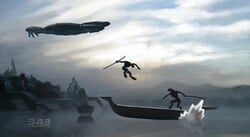
Covenant Era[edit]
In 852 BCE, the two races signed a treaty known as the Writ of Union to form the early Covenant.[55] However, the following year, a civil war began on Sanghelios. Numerous Sangheili opposed the Writ of Union, most notably Ussa 'Xellus. Some Forerunner artifacts were even damaged during the rebellions. In response, Covenant attack fighters were sent to the state of Xellus and destroyed the state and keeps, killing hundreds of Sangheili. This led to the 'Xellus clan fleeing to the southern region of Nwari on Sanghelios to plot against the Covenant, though they were eventually forced to flee to the Refuge.[56]
Sanghelios became the initial capital of the Covenant Empire.[57][1] During this time as the capital, the Covenant would dive into the myriad of Forerunner ruins on the planet.[57] Once the mobile city of High Charity had completed its construction in 648 BCE, Sanghelios returned to Sangheili exclusivity.[1] As part of the Writ of Union, the planet would receive massive imports of manufactured goods and food in exchange for for military service.[57] The planet continued to provide soldiers for the Covenant military for centuries.[1]
During the Human-Covenant War, many Sangheili warriors from Sanghelios joined the Covenant's campaign against humanity until the Great Schism.[12]
Postwar[edit]
After the Human-Covenant War, Arbiter Thel 'Vadam and Rtas 'Vadum returned to Sanghelios after aiding the United Nations Space Command in defeating the Covenant.[58] Most of the Sangheili who served in the Covenant returned to Sanghelios or its colonies when the Covenant was dissolved.[59] However, the dismantling and abandonment of most of the Covenant's religion and politics led to civil unrest and feuding throughout Sanghelios.[1] The Arbiter was considered by many as the leader of Sangheili that truly abandoned their religion. 'Vadam planned to visit each state to make his case for permanent peace with the humans they had battled for so many years.[60] These reforms were not met with universal approval. By January 2553, there was great dissent among disparate Sangheili factions, especially from the more devout believers in the Forerunners' divinity. Some, such as Avu Med 'Telcam and his Servants of the Abiding Truth, saw the Arbiter as a traitorous leader that has betrayed their faith and sought to finish their war with humanity.[61]
Since March 2553, a majority of Sanghelios has become engulfed in a civil war between the Swords of Sanghelios loyal to Arbiter Thel Vadam and the factions—such as the Servants of the Abiding Truth—that sought to worship the Forerunners as gods and exterminate humanity.[62] By 2558, the Arbiter's followers were firmly in control of the planet, though Sanghelios and most Sangheili colonies remain in a tense state.[1] In that year, Jul 'Mdama's Covenant attacked the world igniting a global war.[63] The Battle of Sunaion marked a fatal blow to Jul 'Mdama's Covenant.[46] During the battle, a Forerunner Guardian that had lain beneath the Csurdon Sea for millennia emerged and departed for Genesis.[64]
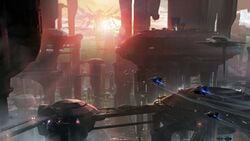
At one point, a human-Sangheili "librarian" team began to research archived Covenant records on the planet.[2]
Created uprising[edit]
- Main article: Created uprising
On October 28, 2558 the Swords of Sanghelios emerged victorious over Jul 'Mdama's Covenant at the Battle of Sunaion.[66] However, when Fireteam Osiris and Blue Team returned through a slipspace portal in a Pelican from Genesis, they found the planet blacked out and realized that Cortana sent a Guardian to Sanghelios too after the Sangheili were too proud to accept her offer. The Spartans were able to track the Arbiter and his surviving people to Nuusra where they reunited with the Swords of Sangheilos, Commander Sarah Palmer and Dr. Catherine Halsey. The Arbiter invited them to join them for a meal while Halsey revealed that she had managed to use the Forerunner technology in the area to make contact with the UNSC Infinity which would appear off the far side of Suban for fifteen minutes the next day at eighteen hundred hours standard time. Palmer explained that soon after Cortana sent out her manifesto, a Guardian arrived on Sanghelios and began taking most of what remained of 'Mdama's Covenant fleet with its standard armament before using an EMP to shut down power across the hemisphere. Rumor had it that the Guardian was on the other side of the planet blacking out that side too since its effect had a limited range. The next day, the humans departed Sanghelios in the Pelican recovered from Genesis and managed to avoid any trouble while rendezvousing with Infinity. However, the Arbiter received reports of Forerunner soldiers actively pacifying cities that resisted the Guardian.[67]
By 2559, the Created had taken control of the planet. An administrator was installed to a position of power. All keephold forces were disarmed and disbanded and local security was to be handled by armigers. Three days after the Razing of Oth Sonin, a High Gathering was held between Arbiter Thel 'Vadam and several high kaidons. Here, the Arbiter proposed the Concert of Worlds, a formal alliance between all Sangheili planets, including Sanghelios. However, the lack of commitment seen at the meeting led the Arbiter to suspect that many of the high kaidons were placing their own interests above the need to stand strong and united against the threats of the Jiralhanae, Kig-Yar, mercenaries, and even vestiges of the San'Shyuum.[68]
After Cortana's death on Installation 07, the Created relinquished their grip on Sanghelios and the rest of Urs system. While many keeps and kaidons on Sanghelios remained steadfast in their support on the Swords of Sanghelios, others sought other factions to pledge their allegiances, with the Banished being well received by some keeps; some of these keeps even allowed the Banished to enter the Urs systems without problems, starting a conflict between the Swords and the Banished on Sanghelios' moon, Suban.[8]
Government and society[edit]
- "They ruled their world with pride, and vigilance, surviving the perils of both land and sea. These were the Arbiters of old; part king, part judge. Warrior-rulers unlike any of which would follow."
- — A San'Shyuum scribe, referring to the ancient Arbiters that led Sanghelios[69]
Sanghelios is considered to be the cradle world and the center of government of the Sangheili.[1] As with the nature of Sangheili governments in general, the planet has no global capital and most of Sanghelios' inhabitants live in city-states led by and named after a particular Sangheili family.[70][71] A given state is governed by a single clan residence and assembly house known as a keep, headed by a kaidon selected by a council of elders. There are usually a number of "client keeps" belonging to different clans under the leading keep's rule,[72] though a state's elders will assume the kaidon's clan name as a title signifying their position, regardless of the name of their own family keep.[73] The states on Sanghelios vary greatly in size and wealth, ranging from small, rural ones like Mdama to urban city-states like Ontom, which mix ancient Sangheili architecture and modern structures and aesthetics.[74] As a developed Sangheili world, Sanghelios is host to hundreds of different keeps competing for power and influence by utilizing both politics and martial force.[14]
Sanghelios was once led by an Arbiter, a title that was part king and part judge.[69] During the early years of the Covenant, Sanghelios was governed by the Council of City States.[5] The planet was initially used as the capital of the Covenant, until the mobile city of High Charity completed construction in 648 BCE. Afterwards, Sanghelios returned to Sangheili exclusivity, though the planet remained under the Covenant's control and served as a central world in the empire's dominion.[1] After the beginning of the Great Schism and the Covenant's resulting dissolution, Sanghelios' states briefly remained divided. However, during the ensuring Blooding Years, a civil war in which numerous Sangheili clans and factions battled for dominance over Sanghelios and the Sangheili species, the Swords of Sanghelios effectively became the single world government for the planet. Led by Arbiter Thel 'Vadam and a grand council of kaidons, the Swords of Sanghelios attempted to quell any faction that attempted to seize control of the planet for themselves.[7] Rear Admiral Horatio Temkin served as the United Nations Space Command's ambassador to Sanghelios in 2558.[75]
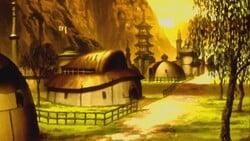
Culture[edit]
Culture on the planet is based around a type of feudal manorialism with Sangheili on Sanghelios live in tightly-knit clans.[14] Outside the cities, some of which feature towering structures of both classic Sangheili and Covenant-era designs,[74][76] Sanghelios' landscape has stayed mostly unchanged for several millennia; the terrain is primarily agricultural, and the keeps typically follow ancient, pre-Covenant architectural styles.[73] Those who committed crimes against the government may have been allowed to fight to the death in an arena. During the Sangheili's long service with the Covenant, the Covenant had a large presence on the planet.[77] Clans and cities were allowed to develop in isolation, but any individual who renounced Sanghelios or rebelled against the government could face imprisonment or execution.[78]
Sanghelios is the location of the single greatest population of Sangheili.[1] Most of Sanghelios' population remains on the planet for their entire life. However, those who showed either intellectual or physical skill were often recruited by the Covenant.[12] By 2552, Sanghelios was inhabited by approximately 8.132 billion individuals.[3] However, the population sharply dwindled to less than four billion after the Blooding Years, a civil war that engulfed most of the planet; many of the planet's inhabitants fled to the population centers on Sanghelios' natural satellites of Qikost and Suban.[1] After the dissolution of the Covenant, Unggoy continue to live on the planet as workers for the Sangheili, and Kig-Yar merchants often visit to trade with the planet's inhabitants. Human officials occasionally visited for diplomacy,[79] or stayed to work.[2] A few Jiralhanae were permitted to work as laborers for Sangheili masters.[80]
Gameplay[edit]
Halo 5: Guardians[edit]
- Main article: Halo 5: Guardians
Several campaign missions of Halo 5: Guardians take place on Sanghelios including Swords of Sanghelios, Alliance, Enemy Lines, Before the Storm, and the Battle of Sunaion.
A few Warzone and arena multiplayer maps are also set on the planet. This includes Mercy, Attack on Sanctum, and Temple.
Production notes[edit]
Several pieces of concept art for Halo 5: Guardians include a city on land. One similar those concepted would appear in the Spartan Locke Armor Set Gamestop Ad for the game but one would not be seen in the retail title.
Concept art was created for Halo Infinite of Sanghelios, including locations that were ruined and in one instance, a flight of Banshees attacking a Guardian.
Originally, Sanghelios was set to be the Covenant world that would be seen in the episode Transcendence of Halo: The Television Series Season One. This would have caused practical and technical issues, resulting in the location becoming Raas Kkhotskha.[81]
Trivia[edit]

|
Browse more images in this article's gallery page. |
- The name "Sanghelios" comes from the Latin sanguis and the Greek helios meaning "Blood-Sun". It is implied that this may refer to the emphasis on blood in the culture of the warrior Sangheili that live there.
- The Doctor Who episode "Planet of the Dead" features a planet called San Helios, which is also part of a triple star system.[82]
- In Halo: The Cole Protocol, Sanghelios is mistakenly referred to as "Sanghelion" in chapter headings.[83]
Gallery[edit]
Concept art[edit]
Concept art of Sanghelios for Halo 5: Guardians.
Concept art of ruins, with a Shuul'se-pattern Kraken to the side.
Early concept art exploration of Sanghelios for Halo Infinite.
Early concept exploration of a water-based location on Sanghelios for Halo Infinite, later canonized as Feldokra.
Early concept art for Halo Infinite showing Kelly-087 meeting with Thel 'Vadam in a Swords of Sanghelios base.
Illustrations[edit]
Sanghelios in Halo 5 Guardians.
Sanghelios from the Halo Encyclopedia (2009 edition).
The texture used for Sanghelios (right) in the skybox of Prism.
Screenshots[edit]
Sanghelios as seen in the Bestiarum.
A duel between Fal 'Chavamee and a rivaling Sangheili in forest terrain on Sanghelios.
An unknown aquatic creature which inhabits Sanghelios. It is currently preying upon a Sangheili submerged within water.
Spartan Jameson Locke on Sanghelios.
A UNSC D79-TC Pelican over buildings on Sanghelios.
List of appearances[edit]
- Halo 3 (First mentioned)
- Bestiarum (First appearance)
- Halo: The Cole Protocol
- Halo Legends
- Halo: Evolutions - Essential Tales of the Halo Universe
- The Return (Motion comic only)
- Halo: Blood Line
- Halo: Glasslands
- Halo: Combat Evolved Anniversary (Mentioned only)
- Halo: The Thursday War
- Halo: Mortal Dictata (Mentioned only)
- Halo: Broken Circle
- Halo 2: Anniversary
- Halo: Hunters in the Dark
- Halo 5: Guardians
- Halo: Shadow of Intent (Mentioned only)
- Halo Mythos
- Halo Fractures
- Lessons Learned (Mentioned only)
- Halo: Envoy
- Halo: Legacy of Onyx (Mentioned only)
- Halo: Bad Blood
- Halo Infinite (Mentioned only)
- Halo: Outcasts
- Halo: Sunrise on Sanghelios
- Halo: Battle for the Blood-Moon (Mentioned only)
Notes[edit]
- ^ The term "Sangheilian" has been used in a Halo 3 Plasma Rifle article on Bungie.net, in the Bestiarum's San'Shyuum article, and in the more recent Eleventh Hour reports on Halo Waypoint. In most cases, the term seemingly goes beyond the scope of Sanghelios itself, suggesting that it is an adjective corresponding to the Sangheili people.
Sources[edit]
- ^ a b c d e f g h i j k l m n o p q r s t u v w Halo Waypoint - Universe, Locations, Sanghelios (Retrieved on Apr 13, 2016) [local archive] [external archive]
- ^ a b c d Halo Waypoint: Catalog Interaction - Page 39
- ^ a b c d e f g Halo 3, Bestiarum
- ^ Halo: Warfleet, page 54
- ^ a b Halo: Broken Circle, page 26 (Google Play edition)
- ^ Halo: Glasslands
- ^ a b c d Halo Waypoint: Swords of Sanghelios
- ^ a b Halo: Battle for the Blood-Moon
- ^ Halo: Blood Line, issue 3
- ^ Halo Channel: Encyclopedia
- ^ Halo Waypoint, Catalog Interaction - Page 14 (Retrieved on Jun 1, 2020) [archive]
- ^ a b c d e Halo Encyclopedia (2011 edition), page 311
- ^ Eleventh Hour reports, Report 2
- ^ a b c Halo Waypoint - Universe, Species, Sangheili (Retrieved on Jun 1, 2020) [local archive] [external archive]
- ^ Halo Encyclopedia (2011 edition), page 130
- ^ Halo 5: Guardians
- ^ Halo: The Cole Protocol, page 90
- ^ Halo: Broken Circle, page 35
- ^ Halo: The Thursday War, page 205
- ^ Halo: The Cole Protocol, page 159
- ^ Halo: The Cole Protocol, page 188
- ^ Halo: The Thursday War, page 79
- ^ Halo: Evolutions - The Return
- ^ Halo: Shadow of Intent
- ^ Halo: The Thursday War, page 261
- ^ Halo: Broken Circle, page 25
- ^ Halo: Broken Circle, page 36
- ^ Halo: Broken Circle, page 90
- ^ Halo: Hunters in the Dark, page 102 (Google Play edition)
- ^ Halo: Hunters in the Dark, page 137 (Google Play edition)
- ^ Halo: The Flood, page 5
- ^ Halo: The Thursday War, page 62
- ^ Halo: The Cole Protocol, page 89
- ^ Obl, chapter 14
- ^ Halo: Glasslands, page 19
- ^ Halo Legends, The Duel
- ^ Halo Waypoint: Gek 'Lhar
- ^ Halo 4: The Essential Visual Guide, page 27
- ^ Halo Waypoint: N'tho 'Sraom
- ^ Halo Waypoint: Rho Barutamee
- ^ Halo: The Essential Visual Guide, page 175
- ^ Halo: The Essential Visual Guide, page 11
- ^ Halo: Broken Circle, Chapter 1
- ^ Halo Waypoint: Usze 'Taham
- ^ Halo: Broken Circle, page 38 (Google Play edition)
- ^ a b Halo Waypoint - Universe, Locations, Sunaion (Retrieved on Apr 13, 2016) [local archive] [external archive]
- ^ Halo Legends, Origins
- ^ Halo Encyclopedia: The Definitive Guide to the Halo Universe, page 120 (2011)
- ^ Halo Waypoint - News, Canon Fodder, Surface Features (Retrieved on Nov 8, 2020) [local archive] [external archive]
- ^ Halo Waypoint - Games, Halo 5: Guardians, Updates, Warzone Firefight (Retrieved on Aug 18, 2016) [archive]
- ^ Halo: Broken Circle, page 30
- ^ Halo: Contact Harvest, page 147
- ^ Halo: Broken Circle, page 58
- ^ Halo Encyclopedia (2022 edition), page 191
- ^ Halo Encyclopedia: The Definitive Guide to the Halo Universe, page 30
- ^ Halo: Broken Circle, page 37
- ^ a b c Halo Encyclopedia (2009 edition), page 228-229
- ^ Halo 3, campaign level Halo
- ^ Halo: Broken Circle, page 265
- ^ Halo: Glasslands, page 130
- ^ Halo: Glasslands, pages 58-61
- ^ Halo: The Thursday War
- ^ Halo: Legacy of Onyx, chapter 21
- ^ Halo 5: Guardians, campaign level Battle of Sunaion
- ^ Halo Encyclopedia (2022 edition), page 195
- ^ Halo 5: Guardians, campaign level Guardians
- ^ Halo: Bad Blood, chapter 1
- ^ Halo: Outcasts, chapter 1: "Perhaps the high kaidons wanted the Sangheili to remain divided and weak. That was the only explanation Arbiter Thel ‘Vadam could imagine for their squabbling and intransigence, for putting their own interests above the need to stand strong and united. Did they truly expect the Tyrant’s “peace” to protect Sangheili space from the encroachments of the Jiralhanae and the Kig-Yar?"
- ^ a b Halo 2: Anniversary, Terminal Six
- ^ Halo: The Cole Protocol, page 93
- ^ Halo: Glasslands, page 58
- ^ Halo: Glasslands, page 94
- ^ a b Halo: Glasslands, page 57
- ^ a b Halo: Glasslands, pages 135-136
- ^ Halo: Escalation, issue 5
- ^ Halo: Broken Circle, page 47
- ^ Halo: Broken Circle, page 174
- ^ Halo: Broken Circle, page 125
- ^ Halo: Glassland
- ^ Halo: Glasslands, page 134
- ^ The Making of Halo The Series: Hope, Heroism, Humanity, page 156
- ^ San Helios at TARDIS Index File, Doctor Who wiki
- ^ Halo: The Cole Protocol, pages 88, 349

